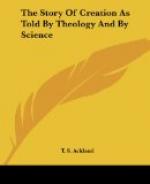Many of the multiple stars may not improbably present to us much the same appearance as the solar system then presented. In many cases we have one large star, with one or more very minute attendants. Such a star is Orionis, a tolerably conspicuous star, which has two companions invisible to the naked eye, but visible with moderate telescopic power. (A telescope of 2.1 inches aperture, by Cooke, shows them well.) Five more companions are visible in a 4-inch telescope. In the large telescope at Harvard no less than 35 minute stars have been seen in apparent connexion with the brilliant star Vega. In all these cases it is true that the distances and periods of the companion stars are very much greater than in the case of the earth; but then our telescopes will only enable us to discern the more distant companions. Any small companion stars holding positions corresponding to those of the four interior planets, would be lost in the light of the primary star; and if, as is suspected, all the heavenly bodies are subject to some resistance, however small, from the medium in which they move, this resistance would in the course of ages diminish the mean distance, and with it the periodic time of the companion stars.
The latter part of the 5th verse has already been considered, and there is no need to recur to it at this point. At the close of the history we shall be in a better position to ascertain if any light has been thrown on that mysterious subject.
Section 5. The second day.
“And God said, Let there be a firmament in the midst of the waters, and let it divide the waters from the waters.
“And God made the firmament, and divided the waters which were under the firmament from the waters which were above the firmament, and it was so.
“And God called the firmament Heaven, and there was evening and there was morning, a second day”
The work of the second and third days evidently has its scene on the earth alone. At its commencement the earth appears to have become distinctly separated from the gradually condensing mass of the solar system, and to have assumed its spherical form. It had, in fact, acquired an independent existence; but it was still in a chaotic state. Its elements, which were hereafter to assume the three forms of solid, fluid, and gas, seem to have been still blended together. Of the three states, fluidity seems to have been that to which the mass most nearly approached. This seems to be indicated by the application of the term, waters, to the two parts into which it is now divided; for the Hebrew has no general word for “fluid,” so that the only method of expressing it was by the use of this word “water” in an extended signification; and all scientific investigations point to the same conclusion. The heat, as yet, must have been so intense that no rocks or metals with which we are acquainted could have remained in a solid form. The sorting out and first arrangement of the materials of the earth, with probably the farther development of a large portion of them by the introduction of a new element, seems to have been the work of the second day.




